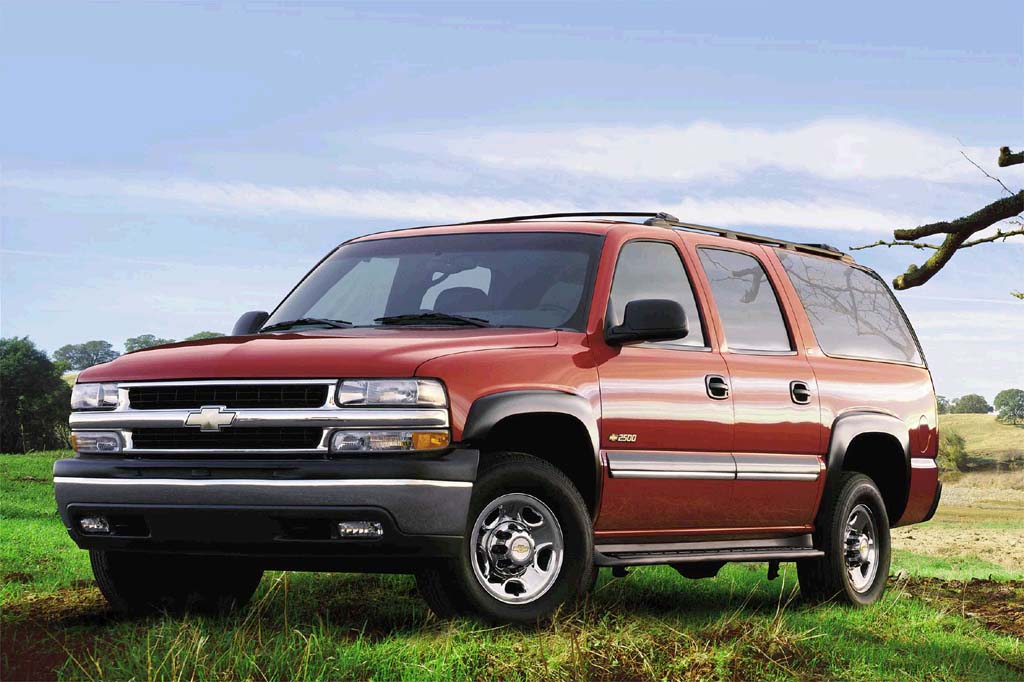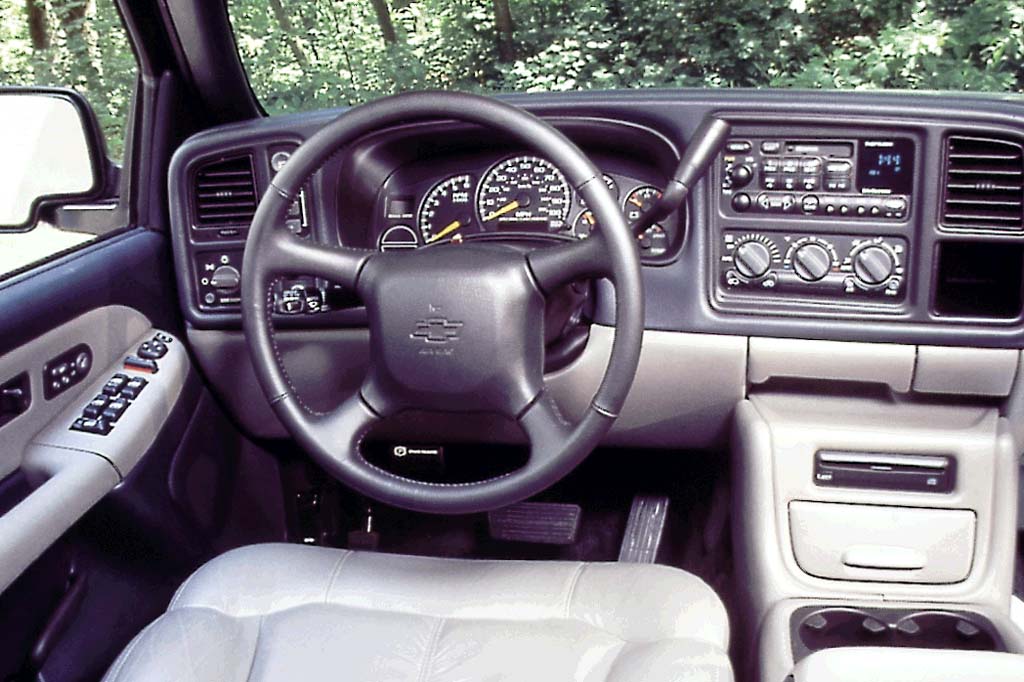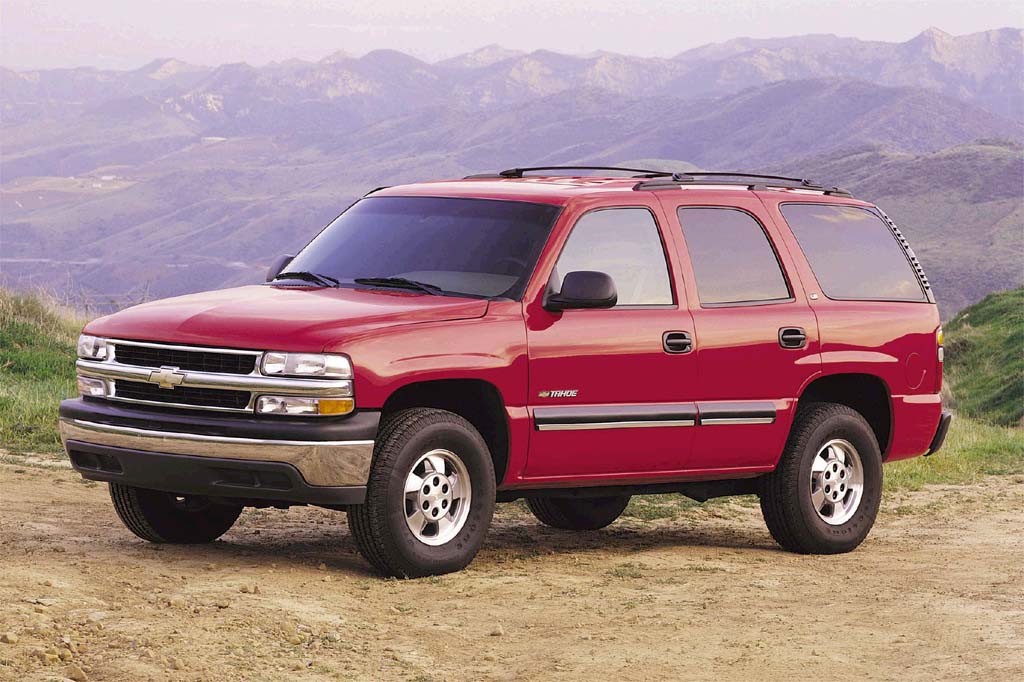| Large SUV; Built in USA |
|
|
| Good condition price range: $3,500 – $14,800* |

2000 Chevrolet Tahoe LT

2001 Chevrolet Suburban 2500

2000 Chevrolet Tahoe interior

2000 Chevrolet Tahoe Z71

2001 Chevrolet Tahoe LS 4WD
| Pros: |
|
| Cons: |
|
GM’s impressive new full-size SUVs are capable, comfortable, and easy to live with. Though too big for a lot of buyers, their size fits nicely into the gap between Ford’s Expedition and Excursion. Don’t buy a big SUV without trying a Chevrolet or GMC.
Overview
In addition to redesigning its full-size sport utility vehicles for 2000, Chevrolet added new V8 engines and standard front side airbags. The Suburban and its GMC Yukon XL equivalent were GM’s largest SUVs–14.7 inches longer than the Ford Expedition, but 7.4 inches shorter than the Ford Excursion. Both the Tahoe and Suburban were 4-door wagons this year. Swing-open rear doors again were standard on both, but a liftgate with separate-opening glass replaced the drop-down tailgate as a no-cost alternative. Tahoes again came only in a half-ton series, while the Suburban was offered in both half-ton 1500 and 3/4-ton 2500 series. Available in base, LS, and LT trim, all models had V8 engines. The base Tahoe held a 275-horsepower 4.8-liter V8. Suburban 1500s and LS/LT Tahoes got a 285-hp 5.3-liter V8, while the Suburban 2500 carried a 300-hp 6.0-liter V8. No more turbodiesels were offered. An automatic transmission was standard, with GM’s Tow/Haul mode designed to optimize shift patterns when carrying heavier loads. Both models could have rear- or 4-wheel drive. 4x4s used Autotrac full-time 4WD, which could be left engaged on dry surfaces. Traction control was a new option for 2WD models. Antilock braking again was standard, but 4-wheel disc brakes were new. Suspension changes included a switch from leaf springs to rear coil springs on Tahoes and Suburban 1500s, plus newly available rear leveling. Both models had 9-passenger capacity if equipped with a front bench seat. A new Suburban option replaced the second-row bench with a pair of buckets. Maximum towing capacity was 8800 pounds for the Tahoe, and 10,500 pounds for the Suburban.
Yearly Updates
| 2001 Tahoe and Suburban A sporty new Z71 off-road option package for 4x4s included wheel flares, lower body moldings, color-keyed bumpers and grille, tubular side steps, and 17-inch wheels. GM’s OnStar emergency/communication system was standard in the LT and Z71 Tahoe and Suburban, and optional in LS versions. With new aluminum cylinder heads, the 6.0-liter V8 gained 20 horsepower. An 8.1-liter V8, rated at 340 horsepower, became available for the Suburban 2500. |
| 2002 Tahoe and Suburban Tahoe and Suburban came standard with a host of previously optional equipment for 2002, triggering base-price increases of up to $9177. Most features of last year’s LS package were now standard, including air conditioning, power windows, power front seats, heated power mirrors, rear climate controls, CD player, and alloy wheels. |
| 2003 Tahoe and Suburban Chevy’s full-size SUVs gained new entertainment options along with an available antiskid system, 4-wheel steering, and adjustable pedals. |
| 2004 Tahoe and Suburban Standard on ’04 Tahoes and Suburbans is a tire-pressure monitor. |
| 2005 Tahoe and Suburban An available navigation system tops 2005 additions to Chevrolet’s large SUVs. Also, GM’s Stabilitrak antiskid system became standard for all Tahoe and 1500 models during the ’05 model year; it is not available on 2500s. Also, the Z71 off-road package is extended from 4WDs to 2WDs. |
| 2006 Tahoe and Suburban Some engine shuffling makes model-year 2006 news for Chevrolet’s large SUVs, which await redesigned replacements due as early 2007 models. Also new for ’06 is an upscale LTZ option package for Suburban. The 6.0-liter V8 is available for the first time in 1500 Suburbans as part of the LTZ package. The package also includes all-wheel drive, unique trim, and 20-inch chrome wheels. |
